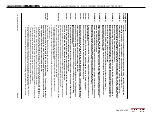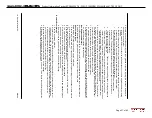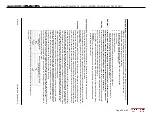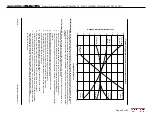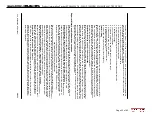
Page 26 of 45
Product Information Packet: ECP844256T-4 - 250HP,1200RPM,3PH,60HZ,449T,TEFC,FOOT,
Installation & Operation 2
−
3
MN408
Doweling & Bolting
After proper alignment is verified, dowel pins should be inserted through the motor feet into the
foundation. This will maintain the correct motor position should motor removal be required.
(Baldor
S
Reliance motors are designed for doweling.)
1.
Drill dowel holes in diagonally opposite motor feet in the locations provided.
2.
Drill corresponding holes in the foundation.
3.
Ream all holes.
4.
Install proper fitting dowels.
5.
Mounting bolts must be carefully tightened to prevent changes in alignment.
Use a flat washer and lock washer under each nut or bolt head to hold the motor feet secure.
Flanged nuts or bolts may be used as an alternative to washers.
W
ARNING:
Guards must be installed for rotating parts such as couplings, pulleys, external fans, and unused
shaft extensions, should be permanently guarded to prevent accidental contact by personnel.
Accidental contact with body parts or clothing can cause serious or fatal injury
.
Guarding
Guards must be installed for rotating parts such as couplings, pulleys, external fans, and unused shaft
extensions. This is particularly important where the parts have surface irregularities such as keys, key
ways or set screws. Some satisfactory methods of guarding are:
1.
Covering the machine and associated rotating parts with structural or decorative parts of the driven
equipment.
2.
Providing covers for the rotating parts. Covers should be suf
ficiently rigid to maintain adequate
guarding during normal service.
Power Connection
Motor and control wiring, overload protection, disconnects, accessories and grounding should
conform to the National Electrical Code and local codes and practices.
For ExnA hazardous location motors, it is a specific condition of use that all terminations in a conduit box
be fully insulated. Flying leads must be insulated with two full wraps of electrical grade insulating tape or
heat shrink tubing.
Grounding
In the USA consult the National Electrical Code, Article 430 for information on grounding of motors and
generators, and Article 250 for general information on grounding. In making the ground connection, the
installer should make certain that there is a solid and permanent metallic connection between the ground
point, the motor or generator terminal housing, and the motor or generator frame. In non
−
USA locations
consult the appropriate national or local code applicable.
Motors with resilient cushion rings usually must be provided with a bonding conductor across the resilient
member
. Some motors are supplied with the bonding conductor on the concealed side of the cushion ring
to protect the bond from damage. Motors with bonded cushion rings should usually be grounded at the
time of installation in accordance with the above recommendations for making ground connections. When
motors with bonded cushion rings are used in multimotor installations employing group fusing or group
protection, the bonding of the cushion ring should be checked to determine that it is adequate for the
rating of the branch circuit over current protective device being used.
There are applications where grounding the exterior parts of a motor or generator may result in greater
hazard by increasing the possibility of a person in the area simultaneously contacting ground and some
other nearby live electrical parts of other ungrounded electrical equipment. In portable equipment it is
dif
ficult to be sure that a positive ground connection is maintained as the equipment is moved, and
providing a grounding conductor may lead to a false sense of security
.
Select a motor starter and over current protection suitable for this motor and its application. Consult motor
starter application data as well as the National Electric Code and/or other applicable local codes.
For motors installed in compliance with IEC requirements, the following minimum cross sectional area of
the protective conductors should be used:
Crosssectional
area of phase
conductors,
S
Minimum crosssectional area of the c
o
rre
sponding
protective
conductor
,
S
p
mm
2
mm
2
S
< 16
S
1
6 <
S
35
16
S
>35
0,5
S
Equipotential
bonding connection shall made using a conductor with a cross-sectional area of
at least 4 mm
2
.








